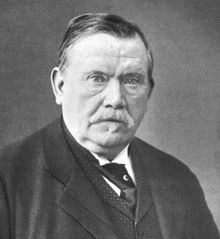Ferdinand Wallbrecht (politician, 1840)
Ferdinand Wallbrecht (born April 7, 1840 in Elze near Hildesheim , † April 1, 1905 in Hanover ) was a German architect , building contractor and national liberal politician .
Life
Ferdinand Wallbrecht attended the building trade school in Nienburg / Weser after completing his apprenticeship as a bricklayer and studied at the polytechnic in Hanover from 1856 to 1861 . In 1860 he became a member of the Corps Saxonia there . From 1861 to 1863 he went on a journey through Germany, Austria and Italy. In 1863 he passed his examination as a master bricklayer and became a partner in the construction business of his brother-in-law, the master mason and mason Karl Lange (1811-1867) in Hanover. After his death he was the sole owner. Through his marriage (in his first marriage) to the daughter of the court mason Constantin Nordmann (1805–1889), Wallbrecht had established a family bond with an influential Hanoverian building industry family. In 1872 he founded the Hannoversche Baugesellschaft and in 1883 became a royal building officer .

In addition to numerous buildings, his most important urban development project in Hanover was the breakthrough of Karmarschstrasse through the old town in two construction phases from 1879 to 1881 and from 1889 to 1890. In the era of Hanover’s city director Heinrich Tramm , Wallbrecht was primarily involved in his construction projects in the 1890s including the sewer system, the Nordstadt Hospital, the market hall, the Maschpark , the Lister Tower and the beginnings of the new town hall .
Wallbrecht was also active outside of Hanover. In 1892/1893 he opened up the Lübeck suburb of St. Gertrud by having the Moltke Bridge built over the Wakenitz from his own resources . At his own expense, he also had Moltkestrasse built, which provided access to the German-Nordic trade and industrial exhibition held in 1895 .
Wallbrecht was a member of the supervisory board of numerous Hanoverian companies. From 1885 he was mayor, in 1890 spokesman and in 1891 senator . For the National Liberal Party , he had been a member of the provincial parliament of the Hanover Province from 1891 and from 1903 to 1905 in the Reichstag as a member of the Hanover Province constituency 9 (Hameln, Linden-Land, Springe). In the last years of his life, he mainly did the preparations for the construction of the Mittelland Canal . Wallbrecht's magnificent tomb is located in the Engesohde city cemetery in Hanover.
Buildings as an architect (selection)
- 1878: Hannover Concert Hall, Am Marstall
- 1879–1881: Provincial estate, Am Schiffgraben (today Lower Saxony Ministry of Finance)
- 1875–1876: Military Riding Institute , Vahrenwalder Straße, Hanover (two outbuildings preserved, including the Royal Riding Hall )
Commemoration and Merit
Street names in Elze , List in Hanover's district and the Wallbrecht Bridge in Lübeck are reminiscent of Ferdinand Wallbrecht. In his personality and his life path, the rise from a trained bricklayer to an economically and politically successful building contractor is combined. As a member of the Reichstag , he also combined his work as an architect and city planner in the late Wilhelminian era and historicism in the Prussian provincial capital Hanover.
literature
- Ernst Voges : Ferdinand Wallbrecht. A picture of life. Hanover 1906.
- Wilhelm Rothert : General Hannoversche Biography Volume 1: Hannoversche men and women since 1866 , Sponholtz, Hannover 1912, pp. 304-307
- Günther Kokkelink , Monika Lemke-Kokkelink : Architecture in Northern Germany: Architecture and handicrafts of the Hanover School 1850–1900. Schlüter, Hannover 1998, ISBN 3-87706-538-4 (biography, works: p. 573)
- Klaus Mlynek in: Dirk Böttcher , Klaus Mlynek, Waldemar R. Röhrbein, Hugo Thielen : Hannoversches Biographisches Lexikon . From the beginning to the present. Schlütersche, Hannover 2002, ISBN 3-87706-706-9 , p. 374.
Web links
- City sign at the Lower Saxony Ministry of Finance in Hanover (built by Ferdinand Wallbrecht)
- Ferdinand Wallbrecht in the database of members of the Reichstag
- Christel Busch: Lübeck street names tell a story: Wallbrechtstraße. In: Our Lübeck of September 22, 2010: [1]
- Obituary for Ferdinand Wallbrecht, in: "Deutsche Bauzeitung, XXXIX. Volume, No. 35, Berlin, May 3, 1905: [2]
Individual evidence
- ^ FL Staub: Corps list of the Weinheimer SC from 1821 to 1906 . Dresden 1906, p. 65
- ^ Fritz Specht, Paul Schwabe: The Reichstag elections from 1867 to 1903. Statistics of the Reichstag elections together with the programs of the parties and a list of the elected representatives. 2nd Edition. Verlag Carl Heymann, Berlin 1904, p. 123.
| personal data | |
|---|---|
| SURNAME | Wallbrecht, Ferdinand |
| BRIEF DESCRIPTION | German architect, building contractor and national liberal politician (NLP), MdR |
| DATE OF BIRTH | April 7, 1840 |
| PLACE OF BIRTH | Elze near Hildesheim |
| DATE OF DEATH | April 1, 1905 |
| Place of death | Hanover |
